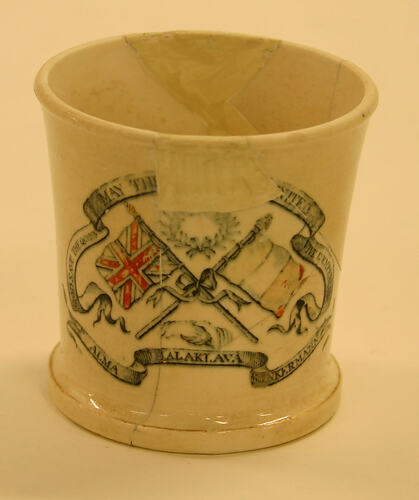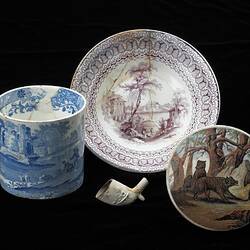Summary
This Crimean war commemorative mug was excavated at the Commonwealth Block site between 1988 and 2003. While it has no maker's mark, it was probably manufactured in Britain. The Crimean war was fought between October 1853 and February 1856 on the Crimean peninsula in Ukraine between Russia and the allied forces of France, Britain, the Ottoman Empire and the Kingdom of Sardinia.
Cultural diversity in Little Lon.
Little Lon was home to a diverse population. Germans, Jews and Irish arrived in the mid 19th century; Chinese, southern Europeans and Syrians (Lebanese) in the 1880s; and Italians in the 1890s. Immigrants sometimes brought objects with them to remind them of home, or purchased new items that re-affirmed national loyalties. Pipes, vases or plates were decorated with flags, military heroes, an Irish lyre or English roses. The amount of foreign currency excavated also attests to diversity of the immigrants who frequented Little Lon.
Homewares.
Numerous crockery pieces were found all over the Little Lon site. Crockery gives us a glimpse of everyday life in Melbourne in the 1880s. In the houses around Little Lon, residents used decorated crockery. Most pieces were cheap earthenware or stoneware, yet provided colour and cheer. Only a few could afford to buy matching sets, and most china was probably acquired second-hand. Some were once expensive pieces. Householders mixed and matched their crockery from the great range of mass-produced designs available. 'Blue and white' and the 'willow' pattern, was the most popular choice and was produced by English potteries from 1790.
Physical Description
This is a small mug that commemorates the Crimean war. It has the names of battles in scroll-work surrounding the French and British flag. This design is on the lower side. There is no manufacturers mark.
Physical Description
Fragments of ceramic mug commemorating the Crimean war, with names of battles in scroll-work surrounding the French and British flag. Design is on the lower side. There is no manufacturers mark. Lettering reads 'MAY THEY EVER BE UNITED GOD SAVE THE QUEEN VIVE L'EMPEROR ALMA BALAKLAVA INKERMANN'. Base diameter 72mm, height 80mm. Made of stone china. 1856+ Britain?
More Information
-
Collection Names
-
Collecting Areas
-
Acquisition Information
Transfer from Heritage Victoria, Industry Superannuation Property Trust, 03 May 2005
-
Manufacture Date
-
Inscriptions
On body: 'MAY THE.. [Y EVER BE U] ...NITED / GOD SAVE THE QUEEN / VIVE L EMPEREUR / ALMA / BALAKLAVA / INKERMANN' (TP).
-
Context Number
19/45
-
Site
[CCS] Australia, Victoria, Commonwealth Block, Melbourne
-
Distinguishing Marks
depiction
-
Activity
-
Specific Activity
-
Decoration
-
Colour
Black and Polychrome
-
Moulding
Crimean War
-
Form
Cylindrical Body
-
Shape
Round
-
Provenance
Scotland?
-
Classification
-
Category
-
Discipline
-
Type of item
-
Exhibition Collection Management
80 mm (Width), 79 mm (Height)
Width = Diameter
-
Dimensions
8.3 cm (Height), 8 cm (Outside Diameter)
Measurement From Conservation. Measuring Method: 6 pieces joined
-
EAMC Measurements
80 (Height), 72 (Outside Diameter)
-
Keywords


